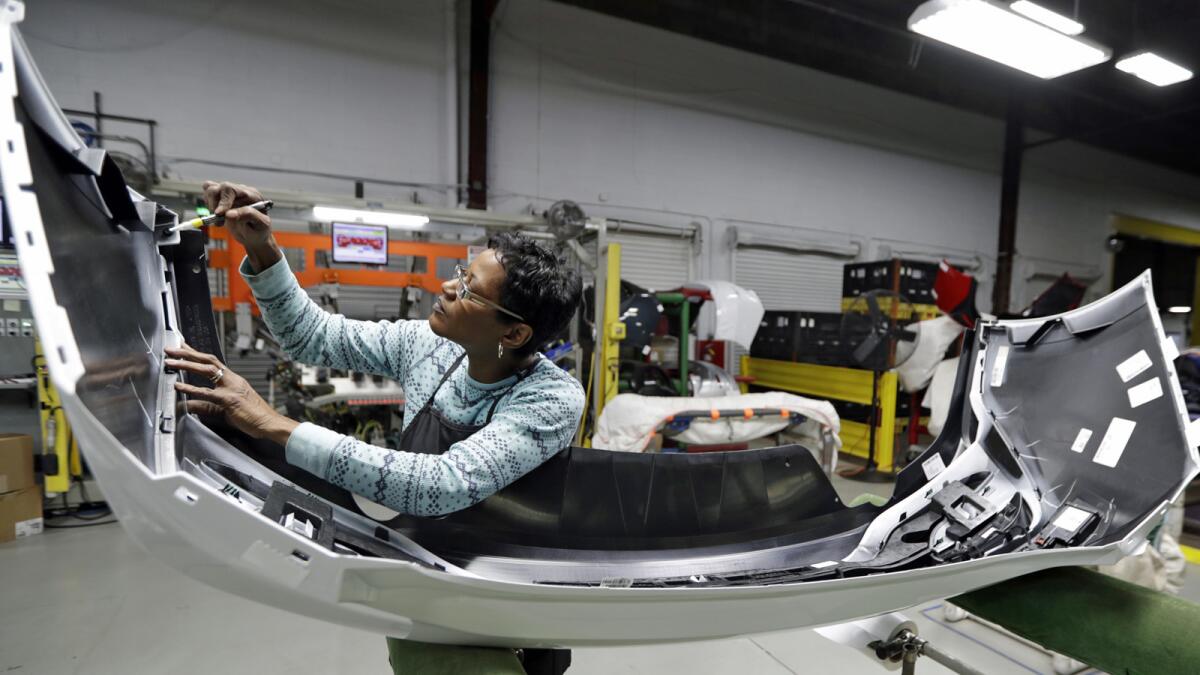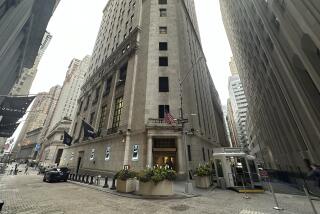U.S. hiring slows to still-solid 155,000 jobs; unemployment rate holds at 3.7%

Reporting from Washington — Job growth slowed significantly in November but still was solid, indicating the economy remains in good shape but is not expanding so quickly that it will lead to sharply higher interest rates.
U.S. employers added 155,000 jobs last month, well below analyst expectations and a steep decline from October’s strong 237,000 figure, the Labor Department reported Friday.
Still, monthly job gains are averaging 206,000 this year, the best since 2015. Even the slower pace of 170,000 over the last three months is close to last year’s average of 182,000 and about double the number needed to keep up with population growth.
The unemployment rate remained at 3.7%, the lowest since 1969. Wages grew at a robust 3.1% in the 12 months that ended Nov. 30. That matched the year-over-year pace from the previous month, which was the best since 2009.
Analysts said the job market remained healthy. Despite what might be considered “slightly disappointing” job creation, “this is far from the Grinch who stole Christmas,” said Mark Hamrick, senior economic analyst at financial information website Bankrate.com.
“The outlook for next year is for slower hiring but not a halt in job creation,” he said.
Investors initially reacted positively Friday, seeing the report as adding to recent signals from Federal Reserve officials that they will slow their pace of interest-rate hikes next year.
The Dow Jones industrial average was headed for an open that was down 200 points. That reversed after the report was released, and the Dow was up modestly in early trading.
“The stock market has been volatile the last few weeks and today’s strength in the employment data will go a long way to calming jittery investor fears,” Chris Rupkey, chief financial economist at MUFG Union Bank in New York, wrote in a research note shortly after the report was released.
But then the Dow turned sharply lower and plummeted more than 660 points at one point. It closed down 559 points, or 2.2%, at 24,389. The broader Standard & Poor’s 500 had a similar percentage decline, while the technology-heavy Nasdaq plunged nearly 3.1%.
The downturn came after a turbulent Thursday session in which a steep decline based on trade concerns was eased by indications Fed policymakers were rethinking the projected path for a key interest rate.
On Friday, worries about the U.S. trade war with China continued to spook investors.
They were fueled in part by comments Friday on CNN by White House trade advisor Peter Navarro indicating the U.S. was ready to place additional tariffs on Chinese imports if ongoing negotiations aren’t successful.
“This is all about global growth,” said Jack Ablin, chief investment officer at Cresset Wealth Advisors, an investment advisory firm. “I think there’s fear that interest rates and trade could collectively weigh on the direction of growth globally.”
Fed officials still are expected to nudge up their benchmark short-term rate later this month, the fourth small hike this year. But investors are anticipating a pullback from a forecast of three more hikes in 2019.
Lael Brainard, a member of the Fed Board of Governors, said in a midday speech Friday that the labor market still showed that “domestic economic momentum has been strong.” The Fed’s gradual interest rate increases “served us well by giving us time to assess the effects,” she said.
It was appropriate to continue that approach, Brainard said, though she noted that future hikes “increasingly will depend” on how the economic outlook evolves.
But James Bullard, president of the Federal Reserve Bank of St. Louis, suggested Friday that the Fed should hold off on the widely anticipated December rate hike. An alternate member of the rate-setting committee, he does not have a vote this month but will starting in January.
The recovery from the Great Recession is approaching the longest in U.S. history and showing signs it has peaked after a boost this year from Republican tax cuts.
The economy grew at a 4.2% annual rate in the second quarter, the fastest since 2014. But the rate slowed to 3.5% in the third quarter as the initial stimulus from the tax cuts faded. Economists are forecasting the rate to slow further in the fourth quarter, to about 2.6%.
The labor market also has been showing signs of slowing — a normal occurrence at this late stage in an economic expansion that probably was delayed by the initial stimulus from the tax cuts.
In addition to November’s lower job growth, the Labor Department revised the figures for the previous two months down by a combined 12,000.
Hiring in the construction industry fell off sharply in November, with the sector adding just 5,000 jobs after payrolls increased by 24,000 the previous month. Leisure and hospitality companies added 15,000 jobs in November after an increase of 56,000 the previous month.
Initial claims for unemployment benefits have been trending up in recent weeks, although they remain near historic lows.
Planned layoffs announced by U.S. employers for the first 11 months of the year are up about 28% from the same period in 2017, outplacement consulting firm Challenger, Gray & Christmas Inc. reported this week.
The nearly 500,000 planned job cuts are the most through November since 2015.
“The job market remains strong for the moment, however,” said Andrew Challenger, the firm’s vice president. “The tight labor market and high demand for skilled workers mean most of those who find themselves unemployed have a good chance of finding new positions.”
The unemployment rate remained at 3.7%, the lowest since 1969. Wages grew at a robust 3.1% in the 12 months that ended Nov. 30.
On Friday, the Business Roundtable — an organization of chief executives of the nation’s largest companies — forecast the economy would grow at a 2.7% rate next year.
Jamie Dimon, chief executive of JPMorgan Chase & Co. and the trade group’s chairman, said Friday that he was not worried about the disappointing jobs report.
“We’ve had some slightly weaker numbers this quarter, but that just might be a bump in the road,” he said.
The Business Roundtable’s economic outlook index declined for the third straight time, although it remained high as chief executives reported labor and material costs were their top cost pressures.
Those results reflect the strong jobs market, which is forcing companies to pay higher wages to attract and retain workers, as well as the spillover from the U.S. trade war with China. The tit-for-tat tariffs between the two countries is leading to rising costs for key materials.
Josh Bolten, the Roundtable’s president, said “trade policy remains a noticeable headwind.”
The U.S. and China declared a 90-day truce in their trade war after President Trump and Chinese President Xi Jinping met at the Group of 20 summit last weekend. But differing interpretations of what was agreed to at the meeting began roiling financial markets Monday. Trump further inflamed the fears by declaring Tuesday that he was “Tariff Man” and prepared to add more if the China talks did not produce results.
Bolten said his group’s members were pleased that U.S. and Chinese officials were talking despite the challenges.
“Ninety days is a short time to address the large set and very complex set of problems that we face with China in the international trading system,” he said.
Though it was not enough time to address all the problems between the two economic superpowers, Bolten said “it’s a good start.”
U.S. becomes a net oil exporter for the first time in 75 years »
More to Read
Inside the business of entertainment
The Wide Shot brings you news, analysis and insights on everything from streaming wars to production — and what it all means for the future.
You may occasionally receive promotional content from the Los Angeles Times.










